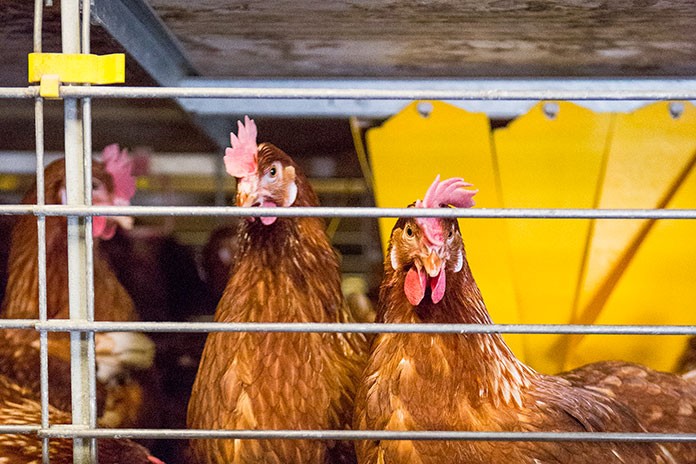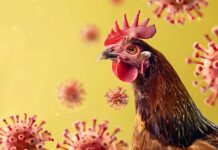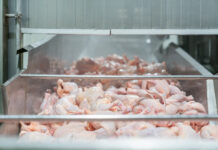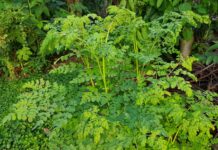
In the past 50 years, selection, initially at the breed level and then using quantitative genetics coupled with a sophisticated breeding pyramid, has resulted in a very productive hybrid for a variety of traits associated with egg production. One major trait currently being developed further is persistency of lay and the concept of the ‘long life’ layer. The recent advent of molecular genetics offers considerable hope that these multiple elements can be balanced for the good of all in the industry including the hens.
The ‘long life’ layer, which will be capable of producing 500 eggs in a laying cycle of 100 weeks, is therefore on the horizon, bringing with it the benefits of a more efficient utilisation of diminishing resources including land, water, raw materials for feed as well as a reduction in waste, and an overall reduced carbon footprint.
The modern layer
The modern commercial layer is capable of producing over 320 eggs in a single laying cycle if she is kept under optimum conditions. A deterioration in egg numbers combined with a decline in shell quality are the main reasons for replacing a laying flock at or around 72 weeks. Poor shell quality at any time not only results in financial loss but also causes major contamination problems for the highly mechanised egg packing and handling equipment. Poor shell quality at 72 weeks does not mean that all hens in an ageing flock produce eggs of reduced quality, rather the variability in egg quality within the flock increases. The long-term maintenance of the tissues and organs involved in producing eggs is therefore a prerequisite for extending the laying cycle of commercial flocks. However, despite a plethora of research in this area spanning over 50 years, we are still ignorant of all the processes and mechanisms controlling the complexity of egg formation nor do we fully understand the functional properties of the individual components of the egg, which are proving to be much more intricate than we ever imagined.
Nevertheless, by 2020, breeding companies claim that they will have developed the ‘long life’ laying hen capable of producing some 500 eggs in a production cycle lasting 100 weeks. This goal is being achieved using selection programs that base decisions on a triangulation of phenotype evaluation of pure lines extending beyond 55wks, cross breed progeny testing (which is now being carried out in diverse conditions throughout the world) and genotype information derived from DNA markers (microsatellite and SNP) which have been validated to show an association with phenotypic traits. Any improvement in persistency in lay must also go hand in hand with sustainable egg quality and the birds must remain healthy throughout the production period. Osteoporosis remains one of the major welfare challenges for the egg industry and therefore cannot be ignored in any discussion relating to extending the laying cycle. In this respect the correct nutrition throughout the laying cycle is of paramount importance.
Overview of the egg forming process
The almost daily production of an egg by a commercial layer is only feasible due to the simultaneous development of a series of follicles in the left ovary. This follows a defined hierarchy with only one follicle reaching maturation within each 24 hr period. Over 12,000 oocytes are present in the ovary at hatch but only a small percentage of these will ever reach maturity. At ovulation, the yolk mass from the largest follicle is captured by the funnel shaped open end of the proximal oviduct or infundibulum. From here it travels down the oviduct and undergoes successive deposition of the different components of the egg. Each component of the egg, the albumen, membranes and the shell, is secreted by different parts of oviduct according to a predetermined sequence of events. During the first four hours, the egg white is formed in the magnum, the longest section of the oviduct. The shell membranes are then deposited as the egg mass passes through the isthmus. Five hours after ovulation the egg mass enters the shell gland, where it spends the next 19 hours. It is during this time that the shell forms.
The formation of the eggshell occurs in 3 distinct phases and is regulated by the precise temporal and spatial secretion of a complex array of proteins, some of which subsequently become incorporated into the calcified structure thereby modifying its biomechanical properties and/or participate in its antimicrobial defences. The resulting interwoven fabric of organic and inorganic constituents forms the mammillary and palisade layers of the shell. In the last 1.5 hours and just prior to oviposition the shell pigment and then the cuticle (a non-calcified organic layer of variable thickness) are deposited. The egg is then ready for oviposition. The timing and process of oviposition is controlled by neurohyopohyseal hormones and prostaglandins secreted by the ovary and to a lesser extent the shell gland. Eggs are usually laid during the first few hours after dawn or when the lights come on in the morning. The next ovulation takes place after expulsion of the egg but can also occur just prior to this in some cases.
The role of the neuroendocrine system
Reproduction in birds is controlled by GnRH-I neurones in the hypothalamus, the region of the brain that integrates environmental and internal endocrine signals. Dunn (2013) suggested that subtle differences in the neuroendocrine system between individuals may be the reason why some birds are capable of a higher persistency in lay than others.
Oestrogen and progesterone are critical to stimulating the growth and maintenance of the left oviduct. These sex steroids are produced by the developing follicles in the ovary at sexual maturity, in response to an increase in the circulating levels of gonadotrophins such as pituitary FSH and LH. As hens age, the cells in the hypothalamus that control these processes are thought to become less efficient. The net effect is that the oviduct loses weight, and functions less efficiently.
The oviduct itself must inevitably suffer damage due to wear and tear, possible low-grade infections, and probably it also becomes refractory to the prolonged stimulation. The number of days when no egg is laid subsequently increases as does the number of defective eggs. However, some individuals are clearly more capable of maintaining a high egg output with good quality shells for longer periods. Thus improving persistency in lay and sustaining egg quality in longer laying cycles should be achievable.
Selection and maintaining laying persistency
The intensive selection for traits such as age at sexual maturity, peak production and laying persistency to 55 weeks has significantly reduced the genetic and phenotypic variations that previously existed in egg number in commercial lines. Indeed, the biological limit of one egg per day for example has virtually been achieved at peak production. It is now common practice for breeding companies to extend their pure line evaluation beyond 75 weeks.
Heritability calculations for egg production at 80-100 weeks are reported to be moderate (h2=0.24) for both white and brown egg layers. There is therefore further scope for genetic improvement in laying persistency.
Selection to stabilise egg quality in longer laying cycles
For many years breeding companies have focused their efforts on achieving higher egg weights (60 g) by peak production and maintaining egg weight at or around this level for as long as possible (65.5 g by 50 weeks). Beyond this, egg weight creeps up with bird age whilst shell quality tends to deteriorate. Excessively large eggs must be avoided if the laying cycle is increased, as large eggs are notoriously difficult to handle. The selection focus now is on controlling egg weight after peak production and keeping egg weight stable beyond 90 weeks of age. The net effect is that the shape of the egg weight curve has become flatter, and “late egg size” has decreased by 5-7 g.
The Haugh unit is the standard selection measurement for albumen quality. Curtis et al., (2005) reported that Haugh units deteriorate with hen age from an average 89.6 to 68.8 over the laying period. The heritability estimates for Haugh units range from 0.21-0.41.
The heritability estimates for Haugh units calculated over a longer laying cycle at 80-100 weeks are still within this range. Thus, through selection it is also possible to maintain acceptable albumen quality in older laying flocks for a longer period in the future. Egg colour is only included in selection in brown egg laying populations for aesthetic reasons and not because this trait relates to the quality of the egg in any other way. The natural variation in brownness is considered to be important in some markets but this is not universal. Heritability for shell colour in brown lines ranges from 0.3-0.53, depending on the breed.
Eggshell strength on the other hand is vital in ensuring the integrity and safety of the egg contents but the problem here is deciding on which measurement to use. Most companies use a combination of several measurements, as they believe that each measures slightly different things. One breeding company for example uses puncture strength as a measure of flexibility and breaking strength as an indirect measure of shell thickness. Heritability estimates for breaking strength measured by quasi-static compression in brown and white lines have been reported to be 0.28 at 80-100 weeks. Thus sustained eggshell strength in older flocks is also a realistic and achievable goal.
Nutrition and feeding for persistency in lay and good egg quality
It is important that pullets receive an appropriate diet throughout the rearing phase so that they meet the recommended adult pullet target weight by 14-16 weeks of age and have the correct body composition to sustain egg production beyond 90 weeks. A specific growth curve must therefore be followed. This is particularly important in the case of the ‘long life’ layer where persistency in lay is expected. Any deviation away from the target pullet weight will influence the mean egg weight during the early laying phase (r2=0.85, p<0.01) and the total egg output for the entire period of production.
Particular attention must be paid to the energy/protein ratio between 11-16 weeks, as increased energy content of the diet enhances the fattening score. Particle size, if not suitable for beak size, can also result in reduced feed intake and therefore weight gain during the rearing phase. Too many dietary changes or rapid changes in diet during the rearing phase should also be avoided. At about 16 weeks of age, the energy and protein content of the ration must be adjusted again ensuring that the hen consumes sufficient feed to cope with growth and the onset of egg production. There are a number of ways of promoting feed intake around this time e.g. use of whole cereals and coarse water-insoluble fibre. It is particularly critical that this feed is both appetizing and always available as medullary bone reserves are being formed and the ovary and oviduct are developing at this time.
During the laying period, the first challenge is to adjust the energy and protein requirements to optimize egg output and to carefully control body weight. The growth requirement is only present for the first few weeks at the onset of egg production. Energy required for maintenance thereafter depends on body weight and feather coverage and therefore increases with hen age. Compilation of literature clearly shows a strong and negative correlation between feed intake and dietary energy concentration. This adaptation is however only partial and so high energy diets can be used during the first part of the laying period to satisfy the continued requirement for growth and to promote heavier, early egg weight without the risk of overfeeding and producing “fat hens”. The hen’s energy requirement however decreases as egg production becomes established.
To minimise fat deposition a lower energy diet can be used at this time, as the birds will be able to partially compensate by increasing their feed intake. Laying hens also adjust their food intake according to the relative size of the particles in relation to the beak size. Varying particle size allows further balancing of the energy intake. The crude protein concentration and amino acids in the layer diet are also important, methionine being the main limiting amino acid (AA). Consumption of an extra 1g of protein per day for example results in an average increase in egg weight of 1.4 g. However the amount of protein consumed is dependent on the dietary energy concentration and the form of the ration. Ideally the protein and AAs concentration in the diet should be estimated relative to the egg weight (mg/g of egg for AAs) and adjusted to optimise egg production throughout the laying cycle. However an additional difficulty is that the heterogeneity of the flock increases with flock age. The best strategy is therefore to focus on maintaining the production of the higher producing hens and to adjust the supply of proteins and AAs accordingly, providing the cost is not prohibitive.
‘Gap’ feeding combined with a ‘paired feeds’ throughout the daylight hours is a useful management tools to improve feed intake efficiency, and flock body weight uniformity during the laying period. Sequential feeding methods whereby the energy and protein levels in the morning versus the afternoon feed are varied is also under investigation. Knowledge of the hen’s specific needs for energy and protein throughout the day would allow optimisation of the daily intake and improved FCR. At present however there seems to be no clear evidence that the hen’s requirement for energy or protein varies throughout the day and that laying hens can adjust their daily intake accordingly.
References are available on request
From the Australian Poultry Science Symposium

















